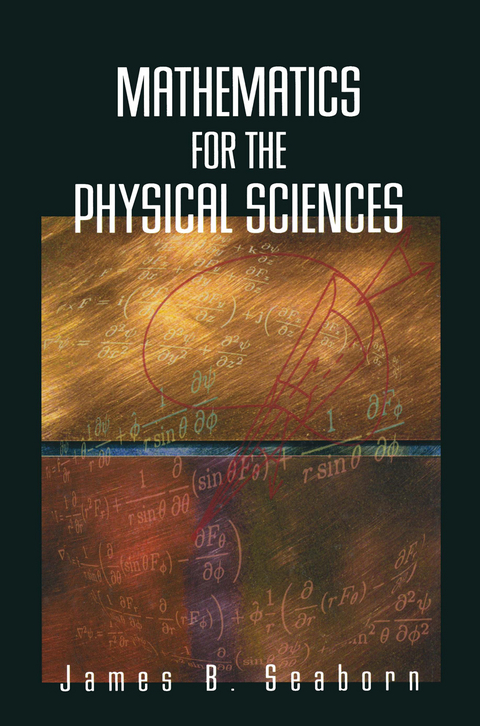
Mathematics for the Physical Sciences
Springer-Verlag New York Inc.
978-1-4419-2959-4 (ISBN)
This book is intended to provide a mathematical bridge from a general physics course to intermediate-level courses in classical mechanics, electricity and mag netism, and quantum mechanics. The book begins with a short review of a few topics that should be familiar to the student from a general physics course. These examples will be used throughout the rest of the book to provide physical con texts for introducing the mathematical applications. The next two chapters are devoted to making the student familiar with vector operations in algebra and cal culus. Students will have already become acquainted with vectors in the general physics course. The notion of magnetic flux provides a physical connection with the integral theorems of vector calculus. A very short chapter on complex num bers is sufficient to supply the needed background for the minor role played by complex numbers in the remainder of the text. Mathematical applications in in termediate and advanced undergraduate courses in physics are often in the form of ordinary or partial differential equations. Ordinary differential equations are introduced in Chapter 5. The ubiquitous simple harmonic oscillator is used to il lustrate the series method of solving an ordinary, linear, second-order differential equation. The one-dimensional, time-dependent SchrOdinger equation provides an illus tration for solving a partial differential equation by the method of separation of variables in Chapter 6.
1 A Review.- 1.1 Electrostatics.- 1.2 Electric Current.- 1.3 Magnetic Flux.- 1.4 Simple Harmonic Motion.- 1.5 A Rigid Rotator.- 1.6 Exercises.- 2 Vectors.- 2.1 Representations of Vectors.- 2.2 The Scalar Product of Two Vectors.- 2.3 The Vector Product of Two Vectors.- 2.4 Exercises.- 3 Vector Calculus.- 3.1 Partial Derivatives.- 3.2 A Vector Differential Operator.- 3.3 Components of the Gradient.- 3.4 Flux.- 3.5 Exercises.- 4 Complex Numbers.- 4.1 Why Study Complex Numbers?.- 4.2 Roots of a Complex Number.- 4.3 Exercises.- 5 Differential Equations.- 5.1 Infinite Series.- 5.2 Analytic Functions.- 5.3 The Classical Harmonic Oscillator.- 5.4 Boundary Conditions.- 5.5 Polynomial Solutions.- 5.6 Elementary Functions.- 5.7 Singularities.- 5.8 Exercises.- 6 Partial Differential Equations.- 6.1 The Method of Separation of Variables.- 6.2 The Quantum Harmonic Oscillator.- 6.3 A Conducting Sphere in an Electric Field.- 6.4 The Schrödinger Equation for a Central Field.- 6.5 Exercises.- 7 Eigenvalue Problems.- 7.1 Boundary Value Problems.- 7.2 A Vibrating Drumhead.- 7.3 A Particle in a One-Dimensional Box.- 7.4 Exercises.- 8 Orthogonal Functions.- 8.1 The Failure of Classical Physics.- 8.2 Observables and Their Measurement.- 8.3 Mathematical Operators.- 8.4 Eigenvalue Equations.- 8.5 The Quantum Harmonic Oscillator.- 8.6 Sturm-Liouville Theory.- 8.7 The Dirac Delta Function.- 8.8 Fourier Integrals.- 8.9 Fourier Series.- 8.10 Periodic Functions.- 8.11 Exercises.- 9 Matrix Formulation of the Eigenvalue Problem.- 9.1 Reformulating the Eigenvalue Problem.- 9.2 Systems of Linear Equations.- 9.3 Back to the Eigenvalue Problem.- 9.4 Coupled Harmonic Oscillators.- 9.5 A Rotating Rigid Body.- 9.6 Exercises.- 10 Variational Principles.- 10.1 Fermat’s Principle.- 10.2 Another VariationalCalculation.- 10.3 The Euler-Lagrange Equation.- 10.4 Exercises.- Appendix A Vector Relations.- A.1 Vector Identities.- A.2 Integral Theorems.- A.3 The Functions of Vector Calculus.- Appendix B Fundamental Equations of Physics.- B.1 Poisson’s Equation.- B.2 Laplace’s Equation.- B.3 Maxwell’s Equations.- B.4 Time-Dependent Schrödinger Equation.- Appendix C Some Useful Integrals and Sums.- C.1 Integrals.- C.2 Sums.- Appendix D Algebraic Equations.- D.1 Quadratic Equation.- D.2 Cubic Equation.- References.
| Zusatzinfo | XI, 245 p. |
|---|---|
| Verlagsort | New York, NY |
| Sprache | englisch |
| Maße | 155 x 235 mm |
| Themenwelt | Informatik ► Weitere Themen ► CAD-Programme |
| Mathematik / Informatik ► Mathematik ► Angewandte Mathematik | |
| Naturwissenschaften ► Chemie ► Physikalische Chemie | |
| Naturwissenschaften ► Physik / Astronomie ► Allgemeines / Lexika | |
| Naturwissenschaften ► Physik / Astronomie ► Theoretische Physik | |
| ISBN-10 | 1-4419-2959-2 / 1441929592 |
| ISBN-13 | 978-1-4419-2959-4 / 9781441929594 |
| Zustand | Neuware |
| Haben Sie eine Frage zum Produkt? |
aus dem Bereich


